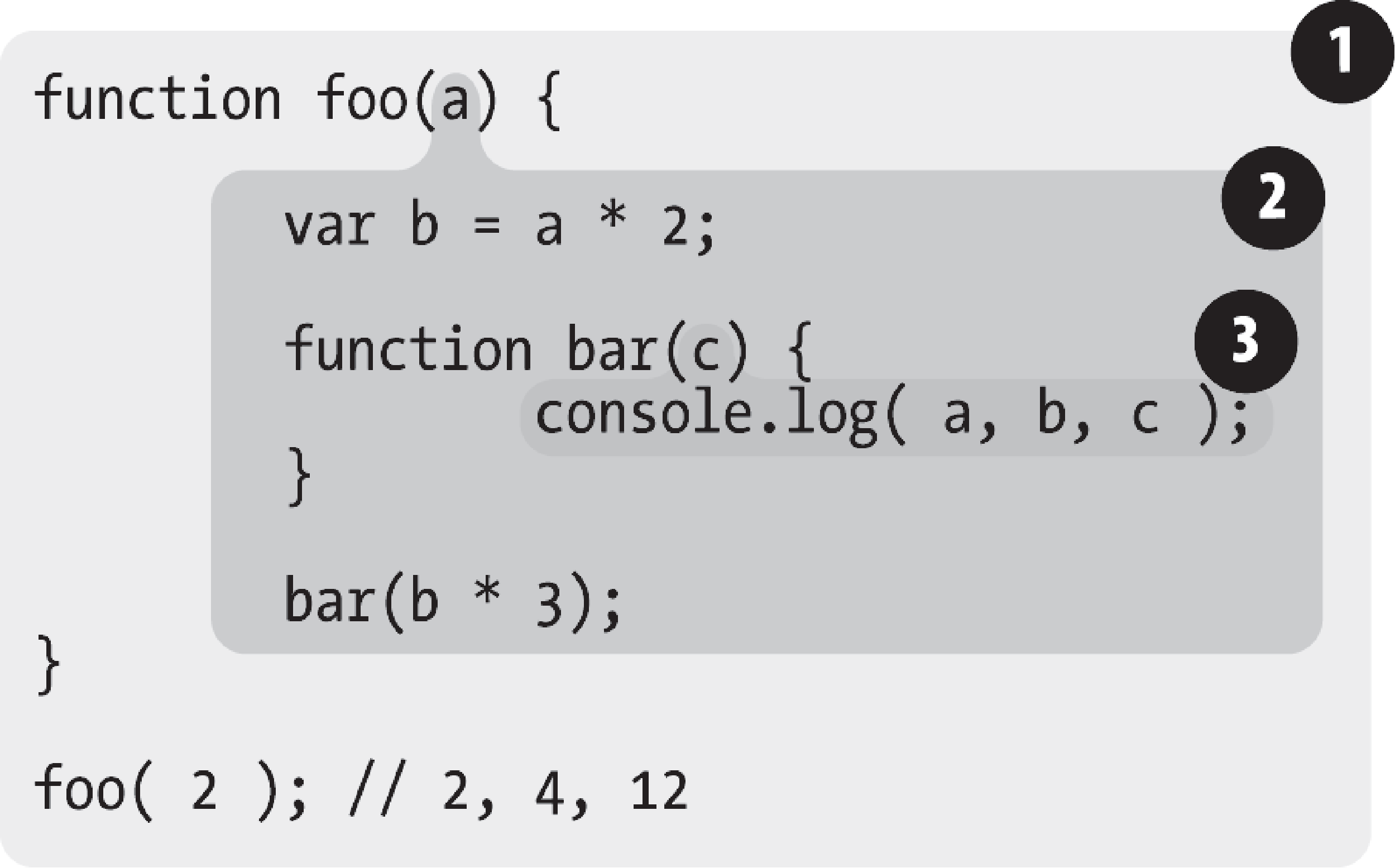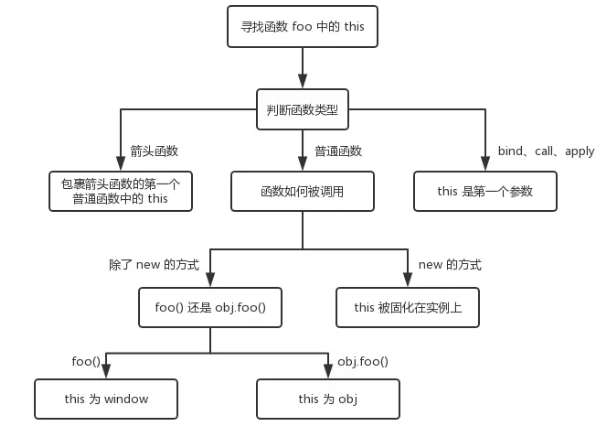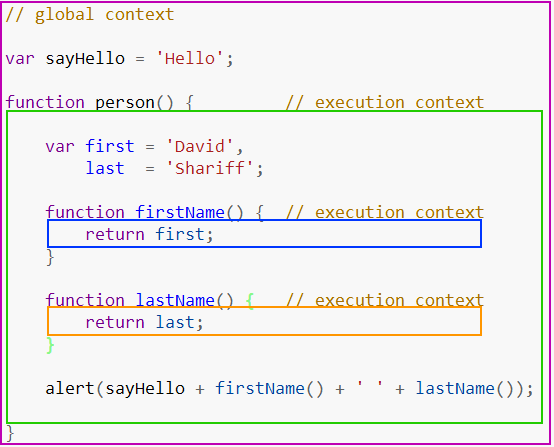On this page
根据名称查找变量的一套规则
作用域链
从当前的执行作用域开始查找变量,如果找不到,就向上一级继续查找。当抵达最外层的全局作用域时,无论找到还是没找到,查找过程都会停止
LHS & RHS
源于编译器的工作原理,用于描述变量查找的方式
LHS 查询
- 一般在等号左边
- 容器查找、变量内存地址查找
RHS 查询
- 一般在等号右边
- 实际上是在查找变量的值
function foo(a) {
var b = a;
return a + b;
}
var c = foo( 2 );
// 1. 找出所有的 LHS 查询(这里有 3 处!) c = ..;、a = 2(隐式变量分配)、b = ..
// 2. 找出所有的 RHS 查询(这里有 4 处!)foo(2..、= a;、a ..、.. b有什么用? - 异常
如果 RHS 查询在所有嵌套的作用域中遍寻不到所需的变量,引擎就会抛出 ReferenceError 异常
function foo(a) {
console.log(a + b) // Uncaught ReferenceError: b is not defined
}
foo(2)执行 LHS 查询时,如果在顶层(全局作用域)中也无法找到目标变量, 全局作用域中就会创建一个具有该名称的变量,并将其返还给引擎,前提是程序运行在非 “严格模式”下。
function foo(a) {
b = a;
}
foo(2);
console.log(b)
// 2
// undefined严格模式
function foo(a) {
'use strict'
b = a
}
foo(2)
console.log(b)解决:
- 一行
- 页面
function foo(a) {'use strict'; b = a } foo(2); console.log(b);如果 RHS 查询找到了一个变量,但是你尝试对这个变量的值进行不合理的操作, 比如试图对一个非函数类型的值进行函数调用,或着引用 null 或 undefined 类型的值中的 属性,那么引擎会抛出另外一种类型的异常,叫作 TypeError
function foo(a) {
a()
}
foo(2)总结
ReferenceError:The ReferenceError object represents an error when a variable that doesn’t exist (or hasn’t yet been initialized) in the current scope is referenced.
- ReferenceError 同作用域判别失败相关
- TypeError 则代表作用域判别成功了,但是对结果的操作是非法或不合理的
哪里出现过:The directive does not have the attribute value which is valid as LHS.
词法作用域
静态的
词法作用域就是定义在词法阶段的作用域,换句话说,词法作用域是由你在写代码时将变量和块作用域写在哪里来决定的,因此当词法分析器处理代码时会保持作用域不变(大部分情况下是这样的)

- 包含着整个全局作用域,其中只有一个标识符:foo
- 包含着 foo 所创建的作用域,其中有三个标识符:a、bar 和 b
- 包含着 bar 所创建的作用域,其中只有一个标识符
例外情况
eval
var b = 2
function foo(str, a) {
eval(str) // 欺骗!
console.log(a, b)
}
foo('var b = 3;', 1) // 1, 3var b = 2
function foo(str, a) {
// eval(str) // 欺骗!
{
let b = 6
}
console.log(a, b)
}
foo('let b = 3;', 1) // 1, 2eval 引入了新的代码块
with
function f(a, b) {
with (b) {
console.log(a)
}
}
//先在指定的对象中查找
f(1, { a: 2 }) //2
f(1, 2) //1哪里用到 with
const app = new Vue({
el: '#app',
data: {
count: 999,
},
})
console.log(app.$options.render)
// function anonymous() {
// with (this) {
// return _c('div', { attrs: { id: 'app' } }, [_v('\n ' + _s(count) + '\n '), _c('span', [_v(' ' + _s(count + 1) + ' '])])
// }
// }
// _c:h
// _v:创建文本节点利:with 语句可以在不造成性能损失的情況下,减少变量的长度。其造成的附加计算量很少。使用 ‘with’ 可以减少不必要的指针路径解析运算。需要注意的是,很多情況下,也可以不使用 with 语句,而是使用一个临时变量来保存指针,来达到同样的效果。
弊:with 语句使得程序在查找变量值时,都是先在指定的对象中查找。所以那些本来不是这个对象的属性的变量,查找起来将会很慢。如果是在对性能要求较高的场合,‘with’ 下面的 statement 语句中的变量,只应该包含这个指定对象的属性
推荐的替代方案是声明一个临时变量来承载你所需要的属性
函数作用域
用 var 声明的变量,自动提升到函数作用域顶部
属于这个函数的全部变量都可以在整个函数的范围内使用及复 用(事实上在嵌套的作用域中也可以使用)。这种设计方案是非常有用的,能充分利用 JavaScript 变量可以根据需要改变值类型的“动态”特性。
- 参数作用域
function fun(x, f) {
// debugger
var x;
var y = x;
f = () => x
x = 2;
console.log(x, y, f())
}
fun(1)var x // 没有右值,只有静态语音,没有运行时语义
var x = undefined // 都有function fun(x, f = () => x) {
var x;
var y = x;
x = 2;
console.log(x, y, f())
}
fun(1)- 两层作用域,参数作用域的 x,函数作用域的 x
- 函数作用域的 x 初始值复制外层 (参数作用域) 的 x
function fun(x, f = () => x) {
// var x;
var y = 'a';
x = 2;
z = 'z'
console.log(x, y, f())
}
fun(1)x 在 参数作用域找到了,不会挂到 window
- IIFE
块级作用域
代码块{}
使用 const,let 声明的变量,范围是块级作用域
for
if (true) {
let a = 1
}
console.log(a)- with
- catch
try {
console.log(a)
} catch (e) {
console.log('catch', e)
}
console.log('out', e)hoisting
console.log(a)
//...
var a = 1var a;
console.log(a)
//...
a = 1let 提升吗
console.log(a)
let a;总结
- let 的「声明」过程被提升了,但是初始化没有提升。
- var 的「声明」和「初始化」都被提升了。
- function 的「创建」「初始化」和「赋值」都被提升了。
执行上下文
this + scope
动态的调用者 + 静态的被调用者
- 全局代码— 首次执行代码的默认环境。
- 函数代码——每当执行流程进入函数体时。
- eval 代码 - 要在内部 eval 函数中执行的文本。
this 的指向
this 的值是在执行的时候才能确认,定义的时候不能确认
直接调用
this 指向 window
function foo() {
console.log(this.a) //1
}
var a = 1
foo()间接调用
谁调用了函数,谁就是 this
function fn() {
console.log(this)
}
var obj = {
fn: fn,
}
obj.fn() //this->obj类的实例
在构造函数模式中,类中 (函数体中) 出现的 this.xxx=xxx 中的 this 是当前类的一个实例
function CreateJsPerson(name, age) {
//this是当前类的一个实例p1
this.name = name //=>p1.name=name
this.age = age //=>p1.age=age
}
var p1 = new CreateJsPerson('abc', 48)箭头函数
箭头函数没有自己的 this,看其外层的是否有函数,如果有,外层函数的 this 就是内部箭头函数的 this,如果没有,则 this 是 window
let btn1 = document.getElementById('btn1')
let obj = {
name: 'kobe',
age: 39,
getName: function() {
btn1.onclick = () => {
console.log(this) //obj
}
},
}
obj.getName()改变作用域
call、apply 和 bind:this 是第一个参数
function add(c, d) {
console.log(this.a + this.b + c + d)
}
var a = 10
var b = 20
var o = {
a: 1,
b: 3,
}
add(30, 40) // 10 + 20 + 30 + 40 = 100
add.call(o, 5, 7) // 1 + 3 + 5 + 7 = 16
add.apply(o, [10, 20]) // 1 + 3 + 10 + 20 = 34
add.bind(o)(1, 2) // 1 + 3 + 1 + 2 = 7(0, function)(param)
逗号运算符,对它的每个操作数求值(从左到右),并返回最后一个操作数的值
https://developer.mozilla.org/en-US/docs/Web/JavaScript/Reference/Operators/Comma_Operator
const obj = {
fun: function () {
return this;
},
};
console.log(1, obj.fun());
console.log(2, (0, obj.fun)());(0, obj.fun)() 等价与 fun = obj.fun; fun()
寻找 this


最佳实践
- 不使用 var,const 优先,let 次之
- 避免 this